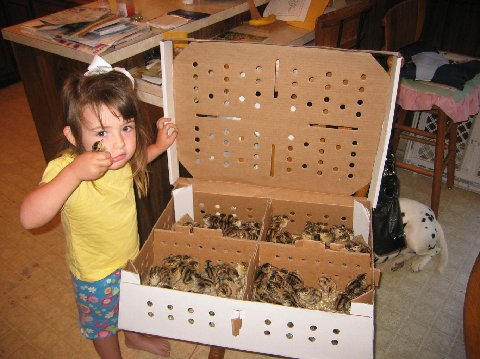When your chicks arrive at the Post Office, open the boxes and LOOK at your chicks. The chicks should seem lively, although warmth and travel may make them a bit sleepy. After all, they are only babies! God designed chicks to travel on stored food for up to 72 hours. As long as the birds are delivered in good time with good air flow, they should do well.
Quiz time: Which part of the egg becomes the chick– the shell, (obviously not), the yolk or the white? (Think about it, and don’t cheat! Answer below– )*

Make the postal employees see any casualties before you leave the premises. We include an extra 4% with all orders, but losses larger than ten should be noted. All insurance claims must be inspected by the post office, and originated on YOUR end -despite what any USPS employee might say. Logically, we would not be able to verify any damage or loss from our end . We have had claims denied because postal employees were not able to view the claimed material. Although our claims have been few, we want you to get your money back if there is an incident.
However, if your package was later than the Post Office guarantee, those postage claims (postage claims for late delivery only) originate on OUR end…
Getting your pheasant chicks to feed and water within a very short time is essential to their health and viability. It is best to have your rooms set up and temperature-regulated before the chicks arrive. If you are unsure of the settings, please contact us before the shipment is sent. Start with a pre– starter or starter ration, graduate to grower, and when fully grown use a maintenance feed. Avoid feeding cracked corn only or you will have the original B-2 bomber! (fat birds)
Airflow is another important ingredient in your brooder room. With a small batch you might be able to use the existing air in a room without incident. However, the more birds you have, the more “fowl” and stale the air can become, and therefore many growers use a forced air system the always keeps a fresh supply coming in to the room with an escape vent on the other side.
The bedding you lay down for your chicks is important! Unusual die-out numbers in the first week can occur with small-particle bedding. Even if you “got away” with using sawdust for years, your chicks are at risk of eating the “fines” and filling up with “junk food” instead of good nutritious feed during their early exploratory days. Use large shavings or straw or cover sawdust or fine particles until the birds are old enough-around a week old– and know what real food is.
“I had very good luck with the chicks last year after they stopped eating the sawdust (which you warned me about). They turned out to be beautiful birds, and everyone who tried them were impressed. And yes, I will be going to straw this year with the chicks…”
-comment from actual customer-
The decision to add nutrients, vitamin supplements or medications in water and feed is up to you. As a practice we do not medicate unless there is an indication of illness. Probiotics (good bacteria – think yogurt for birds–) are a good idea in the feed, and some growers routinely add a coccidiastat to the feed.
Although we can try to help you pinpoint problems, we cannot diagnose illnesses over the phone. Please educate yourself before raising birds concerning possible problems and best brooding practices. The North American Gamebird Association (NAGA) is a good source of professional information. Various membership levels are offered and include a directory of game farms/ hunting preserves and a subscription to the NAGA News publication as well as legal and political representation before state and national government.
Two very helpful but out-of-print publications are Gamebird Propagation, a compilation of various methods in use by the late author John Mullin and The Growers Reference on Gamebird Health by the late Dr. Swartz.
**Now, concerning which part of the egg becomes the chick– About 90% of the folks we’ve asked say the yolk. And 90% of the people we asked were very, very wrong. The yolk is the food sack for the developing chick. Doesn’t it have the most flavor? The white has the DNA for the embryo. The remaining nutrient-rich yolk is sucked into the chick through the navel shortly before hatching and provides enough food for about 72-hours. And THAT is how a chick can survive the trip from our farm to yours. And some say that “just happened!” Isn’t God wonderful?
We hope this rudimentary information is helpful to you. If you need more information, please feel free to contact us.
Peg & Sam Ballou and the Elkhorn Farms staff.
